Michael Thomas Perone's Blog, page 14
July 7, 2022
Lists, Life, and Other Unimportant Details Excerpt, Part 1: The Lists Section
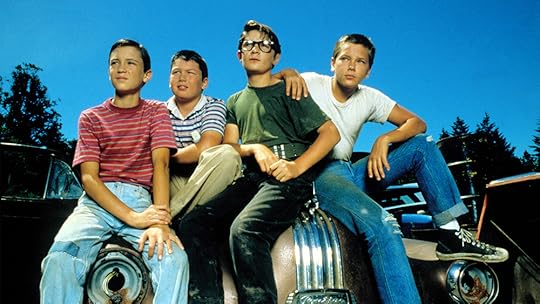 courtesy Columbia Pictures
courtesy Columbia PicturesWhen writers run out of ideas, they can always harvest their old ones. This is what is known in the biz as “returning to the well.” It’s why Kevin Smith is currently working on “Clerks III” and why I’m going to run three excerpts from my book Lists, Life, and Other Unimportant Details for the next few weeks. To be honest, I’m a little (okay a lot) disappointed in the number of people (or lack thereof) who took advantage of my offer to sign up for new blog updates to receive this book for free. Perhaps people are reasoning, “How good can a book be if it’s free?” Well, cards on the table, it’s definitely not as good as Danger Peak. I even say, er, write as much in the Introduction/Warning. (Incidentally, if you’re wondering why it’s titled “Introduction/Warning,” you’ll have to sign up for blog updates to find out!) But instead of defending my little-loved book, I decided to let you guys judge the quality of said book yourselves, so without further ado, here is an excerpt from the first section of the book, Lists. I decided to choose something that was at least tangentially related to Danger Peak, since the movie “Stand By Me” was an obvious influence.
In fact, one of the reasons why I wrote Danger Peak was because I wanted a “Stand By Me” for the ‘80s. You might be thinking, “‘Stand By Me’ is from the ‘80s,” but while the movie was produced and released in the ‘80s, it takes place in the late ‘50s; I wanted a coming-of-age story of friendship that took place in the “Greed-is-good” decade of my childhood. Enjoy! (or don’t!)
Me and Gordie Down by the Schoolyard: My Parallel With “Stand By Me”Though it was released in 1986, “Stand By Me” is still one of my favorite movies of all time. In fact, it’s in my Top 10, though I hadn’t seen the entire movie until the early 2000s, 15 years after its debut. (Until then, I only saw bits and pieces on T.V.) I wish I had seen it earlier, because I would’ve been able to fully appreciate this classic more and realize how much I had in common with the main character, Gordie Lachance, played by Wil Wheaton (he of T.V.’s “Star Trek: The Next Generation” fame, a show I never really paid much attention to, like all the other “Star Trek”s).
Along with Ralphie from “A Christmas Story,” Wil’s character was one of the first to feature a future version of himself narrating his past events, courtesy the always welcome Richard Dreyfuss, a device that was later stolen by “The Wonder Years” and (somewhat less effectively) “How I Met Your Mother.” (If Ted’s younger self is already grown up on the show, why does his older self sound like Bob Saget?)
Roger Ebert once noted that if you watch enough movies, you’ll eventually see a character who’s exactly like you—or at least some former version of yourself. For him, that movie was Joe Dante’s “Matinee.” He also identified with a main character who was in his childhood, this one a scrappy kid who collected sci-fi comics and went to the Saturday double-feature every weekend.
For me, Gordie from “Stand By Me” is almost a carbon copy of how I was and what I was going through during that same era of being 12 years old. (You’d just have to add a few—or a few dozen—pounds to Wheaton’s scrawny frame since I more closely resembled Jerry O’Connell’s plump Vern Tessio.) Here are the reasons why (in no order):
1. Goes on Adventure With Best Friends
Gordie has three best friends in the movie, and I had two. I’m still friends with one of them today (he was the Best Man at my wedding and is a Facebook friend), while I lost touch with the other, similar to how Gordie loses touch with his friends later in life. (Old Spoiler Alert!) I only managed to find my second friend’s siblings on Facebook, and he probably has no idea about any of this.
Gordie goes on a crazy adventure with his buds in the movie, and while my excursions with my own friends weren’t as fantastical (we mostly played Nintendo, listened to Billy Joel, and shared slices at the local pizzeria), there were times when, if not reality-based, our imaginations led us on our own madcap escapades. We searched for “Bigfoot” in the large expanse of woods just behind our homes, we acted like D.J.s on a fake radio station I created called “W.I.E.R.D. T.V.” (we didn’t realize we spelled “weird” wrong), we played “Batman” in our backyards, and one time, we were ambitious enough to evade our parents and visit the requisite “cool kid,” riding on the back of his moped. (Our folks were furious and even went searching for us, as I recall.)
Our transportation mode of choice was of course the bicycle. We rode our bikes all over town like a tiny, extremely nonthreatening “Hell’s Angels.” The bikes certainly came in handy for my Newsday paper route. (Remember when the newspaper was delivered by a boy and his bike? Come to think of it, remember newspapers?) Back then, going from one part of your town to the opposite end was like backpacking cross country or taking a Caribbean cruise. You never realize how small your town is until you actually leave it, and that’s exactly what Gordie says at the end of the movie: “We’d only been gone 2 days, but somehow, the town seemed different, smaller.”
2. Bullying
Like Gordie, I was a victim of bullying, mostly during junior high and high school. I suppose we were all bullied at some point in our lives, but I was called every name in the “Bullying for Beginners” book, including names that didn’t even make sense, like the oxymoron “stupid nerd.” The less said about this, the better.
3. Writing
Like Gordie, I wanted to be a writer when I was a kid, and, as evidence of this book (over 100 entries and counting!), I’m still writing today. Gordie isn’t an athletic kid, so he writes short stories to entertain himself and his friends, which was exactly my favorite childhood pastime. I wrote dozens of “mini-books,” as I called them and used to even sit outside the porch of my friend’s house and read them to him, as Gordie does in the campfire scene in “Stand By Me.” My stories weren’t as gross as his, and none of them were over 50 pages, but, if nothing else, they were good for a laugh. As one of my friends used to say, “Where do you come up with this stuff?” (He might not have used the word “stuff.”)
4. Older Brother Dies
We learn in the movie that Gordie’s older brother died in a car accident, and while it wasn’t a car that took his life, my older (and only) brother Steven also died, coincidentally the same year “Stand By Me” hit theaters. Throughout the film, Gordie flashes back to the good times he had with his brother, which were undoubtedly tainted by the rose-colored glasses of nostalgia. I had great times with Steven, but there were plenty of times he also teased me good naturedly, as all older brothers must do. I suppose it’s a rite of passage.
Like Gordie, I was also meant to step into my older brother’s bigger shoes. During a visit to a deli in the movie, the store clerk waxes nostalgic about how great Gordie’s brother was at playing football. He then asks Gordie if he also plays. He replies, “No.”
“What do you do?” the clerk asks condescendingly.
During one scene, which I’m still not sure whether it’s a dream sequence or a flashback (or both), Gordie’s father places his hand on his shoulder at his brother’s funeral and solemnly tells him, “It should’ve been you, Gordie.”
While my parents were never that cruel, my Dad expected me to be the next Steven. One time at dinner, he complained to my Mom, “He’s nothing like Steven!” as if it was my job to replace him. I quickly countered, “That’s because I’m not Steven; I’m Michael.” Fortunately, my Mom had my back on that one.
The whole brother subplot is one of the main emotional currents that drives the story. It’s what motivates Gordie to connect with his friends, as my loss is certainly something that’s always in the back of my mind, driving me to reach out to others.
5. Skips AP Classes
Gordie was accepted into the Honors Program in junior high, but he doesn’t want to go; he’d rather be with his friends. I was also enlisted in AP classes when I entered junior high in Seventh Grade, but I chose the “lower track,” Regents, for the same reason. Well, that, and I was also lazy. I wanted to enjoy my childhood, not spend it cooped up in my bedroom for months trying to finish War and Peace. As it turns out, I spent the rest of my childhood cooped up in my bedroom anyway but for completely different reasons.
Also, it didn’t help that I was different from the other kids in my classes and expected to perform more, and I remember one time when my English teacher even called me out, saying, “Someone in this class shouldn’t be here! He should be in Honors, but he’s too lazy!” while staring at me the entire time. It didn’t take long for the kids to figure out who she was talking about. Yes, I wasn’t immune to bullying from teachers either. (See number 2.)
When I was in a band, I wrote a song dedicated to this movie, appropriately titled “Stand By You” (the video for it is now embedded at the bottom of my Bio page), but when I presented it to them, along with my guitarist who helped write the music, a few didn’t get it. They took issue with the line, “You don’t get to be 12 too long.” I was trying to explain how I, just like Richard Dreyfuss in the movie, am obsessed with this age; we keep replaying the events over and over in our minds, wishing the time we had was longer, though it was still just one year.
“But you’re 12 the same amount of time as any other age,” they said.
I should’ve just pointed them to this list or, better yet, told them to watch the movie.
MTP
P.S.: Danger Peak is now available on Amazon and Barnes & Noble:
AmazonBarnes & NobleP.P.S.: Next week’s blog: An Excerpt from the Life Section
June 30, 2022
Danger Peak’s Book Proposal
 courtesy Getty Images
courtesy Getty ImagesAs alluded to in last week’s blog, there’s a lot of behind-the-scenes work that goes into writing and publishing a book that many people might not know. This blog is an example of work I shouldn’t have done. When I first started peddling my manuscript, I made the mistake of writing a full book proposal. I didn’t realize that book proposals are intended for works of nonfiction, not fiction (especially not novels, like Danger Peak). Novels simply have book samples, which are typically the first two or three chapters of the book. Since I did all the work anyway, I’d like to think it wasn’t a complete waste of time, so I’m presenting my book proposal here. And who knows? It may inspire some people to work on their book proposals for their nonfiction work. At the very least, it’ll give people a template.
Summary/PitchWhat is on top of Danger Peak? That is what 13-year-old Robert Kin and his two best friends, wisecracking and loyal Chris and sweet but put-upon Rinnie, want to find out in their small suburban town of the late 1980s. The three teens are members of the motorbike-racing club the Wild Boars, and with the inadvertent help of their eccentric technology teacher Dr. Howard (who prefers to be called “Doctor,” not “Mister,” thank you very much), they build Robert a better, faster, and stronger dirt bike—piece by piece. Haunted by flashbacks of his older brother Danny, who died trying to scale Danger Peak the year before, Robert becomes obsessed with conquering the magical mountain. For the respect of his friends and school, and with the aid of his improved Action Bike, he discovers what lies beyond the peak of the mountain—and maybe even beyond the bounds of Earth itself. Filled with humor, adventure, and, most importantly, heart, Danger Peak is an inspiring story about what it takes to achieve your dreams—and what it means to feel alive.
LoglinesDanger Peak: In the late 1980s, a brave thirteen-year-old boy and his two best friends build a super-powered motorbike with the inadvertent help of their eccentric technology teacher to climb and defeat the magical mountain that killed the boy’s older brother the year before.
or
Danger Peak: A year after his older brother dies attempting to climb the mysterious, magical mountain Danger Peak, a brave thirteen-year-old boy is determined to discover what lies atop this infamous mountain with the aid of his two best friends, the inadvertent help of his eccentric technology teacher, and a super-powered motorbike.
AudienceThe ideal target age for Danger Peak is between 10 and 14; the story is not meant for little kids, but that particular age range can still fantasize about wielding a customizable, super-powered motorbike before they’re legally allowed to take their driving test. Danger Peak is based on a short story I wrote over 30 years ago when I was 11 years old. Having written the main beats of the story when I was a child myself helped capture the preadolescent tone of the book, and I believe it will help connect with young readers today, as well as hook nostalgia-minded adults who grew up on George Lucas and Steven Spielberg adventures and are longing for the simpler, “totally awesome” time of the ‘80s when the book is set. As evidenced by the slate of movies recently released or scheduled to be released soon (“It” and “It: Chapter Two,” “Top Gun: Maverick,” “Wonder Woman 1984,” “Bill & Ted 3,” and a new “Ghostbusters”), not to mention the continued success of the ‘80s-set ABC hit sitcom “The Goldbergs” and the blockbuster “Stranger Things” franchise on Netflix, the 1980s certainly appear to be back in a big way, and Danger Peak will capitalize on this renewed excitement for the era of “Pac-Man” and big hair.
Inspirations / CompetitionI had three main inspirations when writing Danger Peak: the old-school, 8-bit Nintendo videogame “Excitebike,” the many misadventures I had with my friends while riding our bikes around our neighborhood, and the death of my brother. My literary influences include the following five books. Each is comparable either in tone, plot, characters, or a combination thereof, but they are different enough so as not to compete with my book.
The Magic Moth by Virginia Lee (1973). The Magic Moth is another middle-grade novel that poignantly illustrates how a young death can initially devastate a family but also bring it together, much like countrymen rallying during a war. In Danger Peak, the death of Robert’s older brother exposes the fault lines in his family that were already present, though invisible—in this case, between Robert and his father—but they ultimately work out their differences in the end. Reading The Magic Moth personally hit home for me, as someone who also experienced death in his nuclear family at a young age.Charlie and the Chocolate Factory by Roald Dahl (1964). Dahl’s classic is based on a wonderfully fascinating premise with a unique hook. In essence, it asks its young readers a delicious, one-sentence question: “What’s inside a magical chocolate factory?” In my book’s case, it attempts to intrigue the reader with this query: “What’s on top of a mysterious mountain?” Hopefully, this hook will encourage readers—young and old alike—to crack open the cover.The Best Christmas Pageant Ever by Barbara Robinson (1971). Similar to Danger Peak, this story features mischievous underdogs who aren’t necessarily viewed by the other characters as “heroes,” but they end up saving the day in the end anyway. It taught me to reevaluate certain people others would describe as “undesirable”: the poor, lonely, and vulnerable outcasts of society. Those people usually go on to surprise the lot of us.Mail-Order Wings by Beatrice Gormley (1981). Gormley’s book about a girl who buys a pair of wings from an ad in a comic book that actually grants her the power of flight has an element of magical realism, as does Danger Peak. In other words, there’s truly only one magical object in the story—the titular wings—just as there’s one sole element of magic in my book: the mountain at the center of the main character’s hometown that he is obsessed with conquering. Reminiscent of Mail-Order Wings, Danger Peak is not a complete fantasy filled with elves and orcs like Lord of the Rings or Harry Potter, but nonetheless, the readers are required to check their rational brains once they delve into the imaginative story.Ready Player One by Ernest Cline (2011). Although this is a young-adult novel, not a middle-grade novella like Danger Peak and the others on this list, Ready Player One is still overflowing with ‘80s references, which is even more apparent if you’ve seen the motion picture directed by Steven Spielberg. The key difference is that while the characters in Ready Player One are nostalgic for this particular decade, they’re not living in it; they’re living in a dystopian future with only the memory or secondhand stories of that long-ago era, whereas the characters in Danger Peak are actually living during this decade. From the original “Ghostbusters” and “Star Wars” to “Knight Rider” and Martika songs, I drew on the environment of my childhood while writing Danger Peak to make the story as personal as possible.One way my book is different from these classics is that my characters have more agency in that they’re not simply reacting to things happening to them, as the children who suffer in Willy Wonka’s factory do, for example; they are active participants in the story.
The AuthorA graduate of Loyola University Maryland with a degree in Journalism, Michael Thomas Perone has written for The Baltimore Sun, Baltimore City Paper, Long Island Voice (a spinoff of The Village Voice), and The Island Ear (now titled Long Island Press), among others. Online, he has written for Fatherly, Yahoo!, WhatCulture!, and other websites that don’t end with an exclamation mark. His articles for WhatCulture! covering the world of entertainment alone have been viewed over 374,000 times, and his expertise on critical writing in the music industry has been cited on Wikipedia and featured in national press kits, including for the alternative rock band Toad the Wet Sprocket. For three years in a row, he was a guest speaker on a panel for his alma mater’s Networking in New York series at the Marriott Marquis in Times Square, until the series was discontinued. Networking in New York was a conference designed to aid undergrads and recent graduates of Loyola in finding employment in the publishing industry in New York. He currently works as a Senior Editor in Manhattan and lives on Long Island with his wife and two daughters.
Manuscript SpecificationsDanger Peak will be sold as a commercially friendly paperback, in a trim size of 5.5 in. x 8.5 in., and with a full-color cover and limited to no illustrations inside. The cover will have the book’s title set as an eye-catching logo on top with large, blocky letters and little lightning bolts shooting out the left sides of the “D” in “Danger” and “P” in “Peak,” simulating the words themselves being set in motion. Below the title, there will be a dramatic image of Danger Peak in the background with dark clouds and lightning strikes guarding the mountaintop, while the bottom foreground will showcase a dynamic picture of Robert riding his Action Bike towards the reader while blasting laser bolts from the bike’s mounted mini-laser. At 46,000 words, not including the title page, copyright page, and Contents, the book should run at just under 200 pages. Finally, the book will have 29 chapters, including a Prologue and Epilogue, and each chapter number will have a small lightning bolt behind it, echoing the design of the cover and the overall logo of the book.
Publicity and MarketingBesides selling at the usual places like brick-and-mortar Barnes & Nobles stores and online at Amazon.com, Danger Peak could be sold in outside-the-box areas such as moped and bicycle stores, where the target audience congregates.I plan on heavily promoting this book to potential customers with like-minded interest in ‘80s pop culture, including targeted ads on 80stees.com and Facebook groups dedicated to the decade of excess.I will submit my book for review to the numerous publications I used to write for, including The Baltimore Sun and Long Island Press.To tie in with the ‘80s setting of the book, there could be a viral 8-bit videogame launched on the Internet with graphics and music similar to the original, old-school Nintendo. The game would be hosted on the book’s website and feature the following three levels based on three action-packed chapters of the book:In the first level, you control Robert on his developing Action Bike as he tries to outrun his school’s security guards following close behind through his hometown. In this level, you can use your bike’s turbo charger but only for a limited amount, so you have to time the short bursts of speed carefully.In the second level, you control Robert on his Action Bike as he bypasses the cops chasing him by racing through his town’s forest. In this level, you can use both your turbo charger and built-in laser to knock down the trees in your way, but again, you only have access to these accessories for a limited amount of time, so the player needs to choose wisely.In the third and final level, you control Robert on his Action Bike as he finally climbs Danger Peak, the end goal of the game and book. The player now has full access to Action Bike’s add-ons: the turbo charger for short bursts of increased speed, a mounted laser, and larger tires for the rugged terrain. The player needs to dodge lightning strikes and blast approaching, runaway boulders. If the player successfully reaches the mountaintop at the end of the level, the screen will black out with the following white lettering: “Want to know what’s on top of Danger Peak? You’ll have to read the book!”EndnoteDanger Peak is an inspiring original story that needs to be read. This satisfying adventure yarn will not only appeal to older children and young teens—the book’s primary demographic and age of the main characters—but also to their parents who grew up in the “Greed-is-good” decade and miss hearing Don Henley on the radio and watching “Miami Vice” on T.V. Similar to the Emmy-winning television series “The Wonder Years,” Danger Peak will attract both younger and older generations; the former will see themselves in the story’s heroes, and the latter will get to relive the carefree, innocent days of their childhood. What’s more, the book isn’t content to simply deliver a rollicking adventure; Danger Peak is a personal story about family tragedy and triumph—something anyone with a beating heart can relate to.
MTP
P.S.: Danger Peak is now available on Barnes & Noble and Amazon!
Barnes & NobleAmazonP.P.S.: I ended up not going with the 8-bit videogame idea to market the book on this website. Hey, I’m not made of money!
P.P.P.S.: You can still get my free book Lists, Life, and Other Unimportant Details by following the instructions on top of the Blog/FREE Book page. And speaking of which….
P.P.P.P.S.: Next week’s blog: An Excerpt From Lists, Life, and Other Unimportant Details
June 28, 2022
Danger Peak Is Now Available on Barnes & Noble!
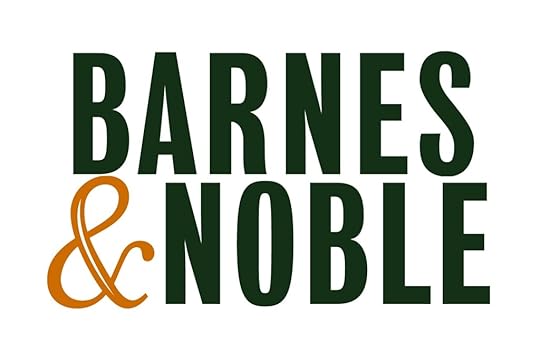 courtesy Barnes & Noble (duh)
courtesy Barnes & Noble (duh)I’ll keep this update short and sweet. Danger Peak is finally available to order on Barnes & Noble! I don’t know why it takes longer for a book to appear there than on Amazon, where it’s been available for two weeks now, but live and learn, I guess. I’ve updated the bottom of each major page of this website (again, not the individual blog posts) with a link to Barnes & Noble, located directly above the Amazon link. If you’d rather order the book from Barnes & Noble instead of Amazon, click the link below:
Barnes & NobleThe book cover and description are missing from the page in the link above because the book was just uploaded to the site, and information still needs to fill in. Also, I realize my Amazon link didn’t appear in the email of my Amazon blog post for my email subscribers, so just in case the same thing happens again here, please copy and paste the link below to order your copy on Barnes & Noble:
https://www.barnesandnoble.com/w/danger-peak-michael-thomas-perone/1141694166?ean=9781627879507
If you want that personal, human touch with an in-store purchase, feel free to ask your local Barnes & Noble to order a copy—or 50!
Thanks a lot for reading, guys (both this blog and, hopefully, my book).
MTP
June 23, 2022
The First (and Probably Last) Danger Peak Photo Essay
 courtesy Google images
courtesy Google imagesFor the past few months, I’ve been blah blah blahing (or should I write “blog blog blogging”) about my road to publication, and since people seem to respond more to visual stimulation these days, I thought I’d take a crack at creating my first Danger Peak photo essay. As the title says, it will also most likely be my last. Here we go!
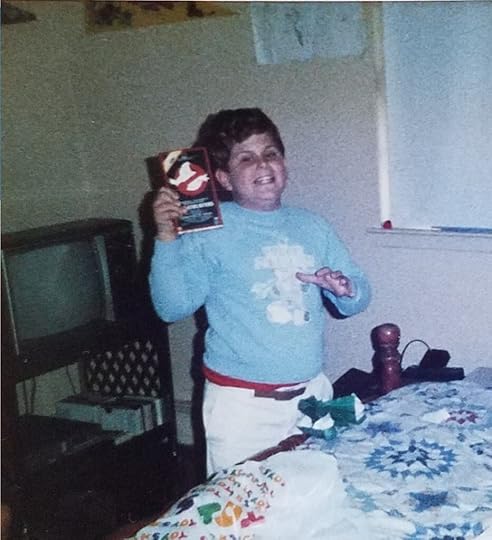 This pic is in my bio, but I wanted to point out how this is my most 1980s photograph of my entire life. For context, it was my (10th?) birthday, and I had just unwrapped “Ghostbusters” on VHS as part of a treasure hunt my sister set up. “Ghostbusters” is a movie I had been coveting for over a year, and after renting it from the local Andor Video (R.I.P., playa) around the corner from my house nearly every week, my parents finally relented and bought me the damn thing, figuring it would be cheaper in the long run. (Remember, this is back when videocassettes cost almost $100 to buy.) But back to the ‘80s references: Besides the obvious “Ghostbusters” tape I’m so proudly brandishing, I’m wearing a “Transformers” sweatshirt; there’s an Atari 2600 to my left; there’s an old-timey, boxy television set, a VCR, and blank, recordable VHS tapes behind me; there’s a Toys “R” Us bag (once again, R.I.P.) on the bed in front of me; and there’s a pennant of Ringling Bros. and Barnum & Bailey Circus (do I need to say it? R.I.P.) on the wall. In fact, there’s actually more ‘80s memorabilia in this photo, but I cropped it out because my sister was in the shot, and I wasn’t sure she’d want to be advertised on this site/blog. In the original shot, there are several posters from Nintendo Power (one last time: R.I.P.) taped to my bedroom wall. And yes, you better believe Nintendo Power gets several shout-outs in Danger Peak.
This pic is in my bio, but I wanted to point out how this is my most 1980s photograph of my entire life. For context, it was my (10th?) birthday, and I had just unwrapped “Ghostbusters” on VHS as part of a treasure hunt my sister set up. “Ghostbusters” is a movie I had been coveting for over a year, and after renting it from the local Andor Video (R.I.P., playa) around the corner from my house nearly every week, my parents finally relented and bought me the damn thing, figuring it would be cheaper in the long run. (Remember, this is back when videocassettes cost almost $100 to buy.) But back to the ‘80s references: Besides the obvious “Ghostbusters” tape I’m so proudly brandishing, I’m wearing a “Transformers” sweatshirt; there’s an Atari 2600 to my left; there’s an old-timey, boxy television set, a VCR, and blank, recordable VHS tapes behind me; there’s a Toys “R” Us bag (once again, R.I.P.) on the bed in front of me; and there’s a pennant of Ringling Bros. and Barnum & Bailey Circus (do I need to say it? R.I.P.) on the wall. In fact, there’s actually more ‘80s memorabilia in this photo, but I cropped it out because my sister was in the shot, and I wasn’t sure she’d want to be advertised on this site/blog. In the original shot, there are several posters from Nintendo Power (one last time: R.I.P.) taped to my bedroom wall. And yes, you better believe Nintendo Power gets several shout-outs in Danger Peak.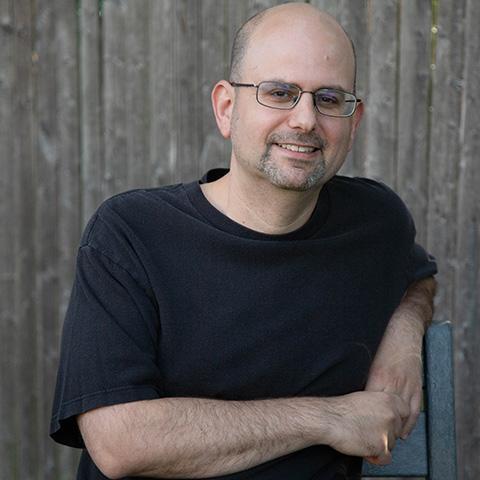 Here is my official headshot for my Amazon author page. Photo courtesy of Nicole Esposito Photography.
Here is my official headshot for my Amazon author page. Photo courtesy of Nicole Esposito Photography.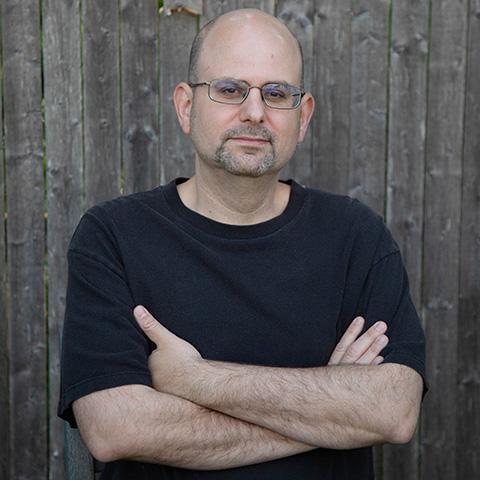 Here is the first alternate headshot. Again, photo courtesy of Nicole Esposito Photography.
Here is the first alternate headshot. Again, photo courtesy of Nicole Esposito Photography.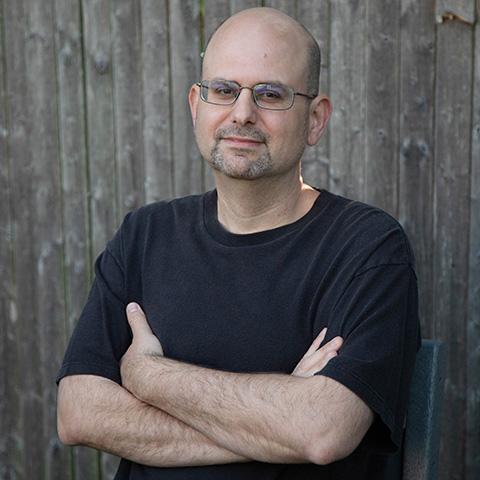 Here is the second and final alternate headshot. Photo still courtesy of Nicole Esposito Photography. I promise this is the last picture of me in this blog!
Here is the second and final alternate headshot. Photo still courtesy of Nicole Esposito Photography. I promise this is the last picture of me in this blog!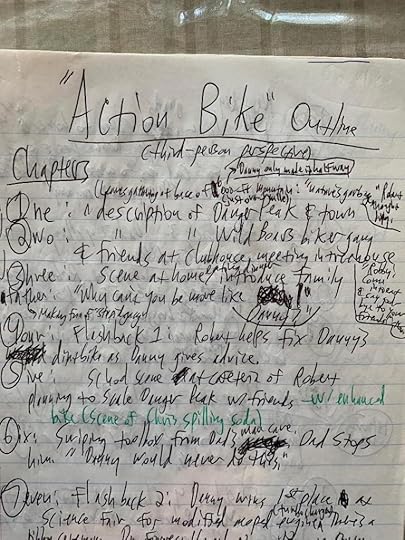 As alluded to in an older blog, here is a snapshot of an early outline for Danger Peak when it was still titled Action Bike. At first, I was a little hesitant to post this behind-the-scenes info since it gives away some of the plot before anyone has had their copy of the book delivered (not even me!), but then I realized no one will be able to read my handwriting anyway. If you can though, congrats! You don’t need glasses!
As alluded to in an older blog, here is a snapshot of an early outline for Danger Peak when it was still titled Action Bike. At first, I was a little hesitant to post this behind-the-scenes info since it gives away some of the plot before anyone has had their copy of the book delivered (not even me!), but then I realized no one will be able to read my handwriting anyway. If you can though, congrats! You don’t need glasses!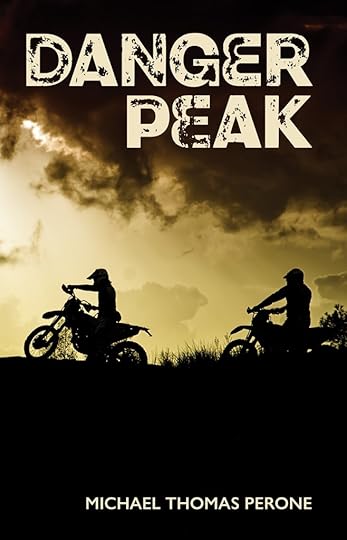 Here is the first rejected cover of Danger Peak. (These rejected covers were already featured on my Facebook profile and in my Twitter feed, but I realize most people don’t follow my social media.) I thought this cover was too “dark and gritty” for what is mostly a lighthearted kids’ adventure. Though there are dramatic elements in my story, I didn’t want to overshadow the fact that hey, this book is actually fun.
Here is the first rejected cover of Danger Peak. (These rejected covers were already featured on my Facebook profile and in my Twitter feed, but I realize most people don’t follow my social media.) I thought this cover was too “dark and gritty” for what is mostly a lighthearted kids’ adventure. Though there are dramatic elements in my story, I didn’t want to overshadow the fact that hey, this book is actually fun.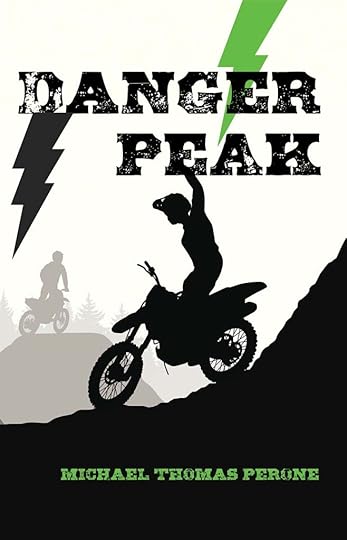 This rejected cover was a runner-up to what was eventually chosen, but I was glad I was able to incorporate the illustration of the kid pumping his fist in the air for the official back cover.
This rejected cover was a runner-up to what was eventually chosen, but I was glad I was able to incorporate the illustration of the kid pumping his fist in the air for the official back cover.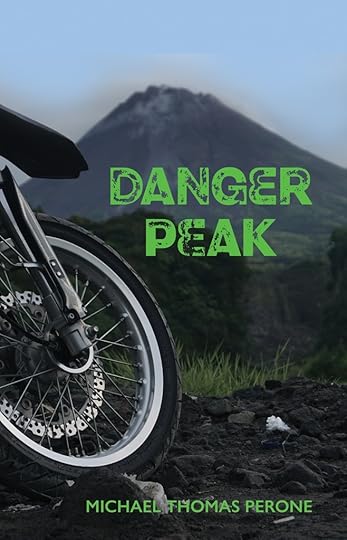 This was my least favorite cover, though, ironically, it was my wife’s and her best friend’s favorite (go figure). I thought it was too serious and sparse looking. Also, that bike tire in the foreground is obviously not from the ‘80s. Oops!
This was my least favorite cover, though, ironically, it was my wife’s and her best friend’s favorite (go figure). I thought it was too serious and sparse looking. Also, that bike tire in the foreground is obviously not from the ‘80s. Oops!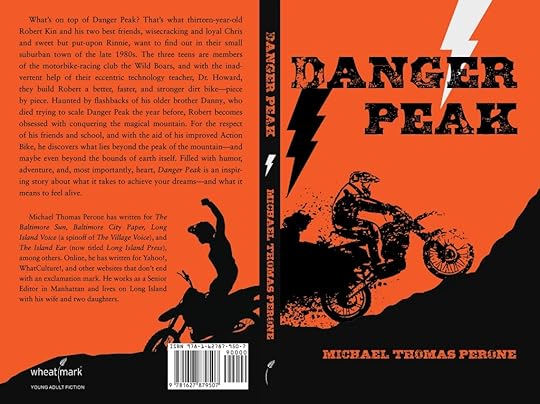 Here is the final full cover of the book, including the back-flap copy and my bio. (Again, this was already posted in my social media, but this is the first time it’s been posted on this website.)
Here is the final full cover of the book, including the back-flap copy and my bio. (Again, this was already posted in my social media, but this is the first time it’s been posted on this website.)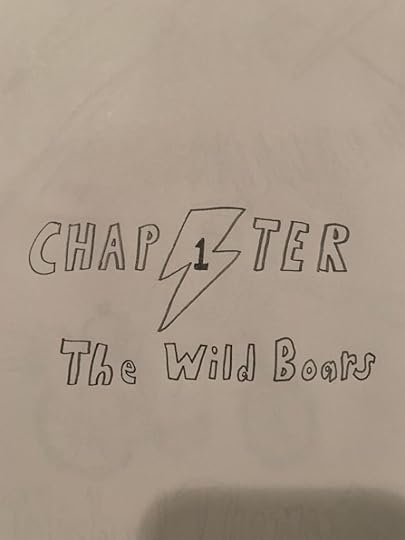 This was the interior design I submitted to my publisher. The lightning bolt has a double meaning. It’s meant to signify the lightning-fast Action Bike that Robert and his friends build throughout the book, and it also illustrates the hazards of Danger Peak itself, which include lightning strikes. I liked the dichotomy of the metaphorical (lightning-fast bike) with the literal (actual lightning bolts on top of the mountain).
This was the interior design I submitted to my publisher. The lightning bolt has a double meaning. It’s meant to signify the lightning-fast Action Bike that Robert and his friends build throughout the book, and it also illustrates the hazards of Danger Peak itself, which include lightning strikes. I liked the dichotomy of the metaphorical (lightning-fast bike) with the literal (actual lightning bolts on top of the mountain).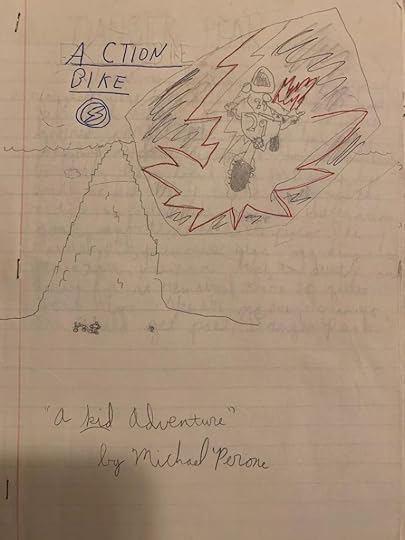 Here is the original cover of Danger Peak that I designed when I was 11 years old and the title was still Action Bike (inspired by the NES game “ExciteBike”). If nothing else, this is proof that I originally wrote this story in 1988.
Here is the original cover of Danger Peak that I designed when I was 11 years old and the title was still Action Bike (inspired by the NES game “ExciteBike”). If nothing else, this is proof that I originally wrote this story in 1988.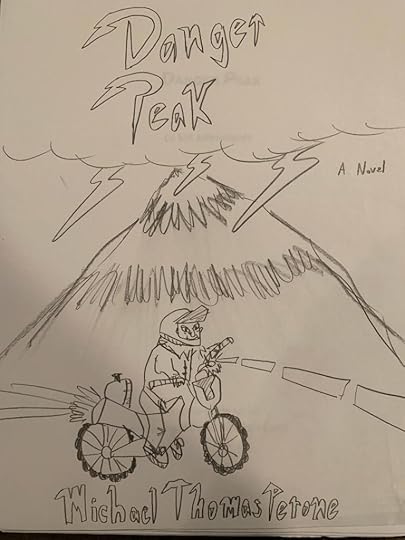 This is the cover design I submitted to my publisher earlier this year. As you can see, there were a few changes made to the final design. As you can also see, my drawing style hasn’t improved much in the past 30 years. (Those rectangular blips blasting out of the front of the bike are supposed to be laser bolts.)
This is the cover design I submitted to my publisher earlier this year. As you can see, there were a few changes made to the final design. As you can also see, my drawing style hasn’t improved much in the past 30 years. (Those rectangular blips blasting out of the front of the bike are supposed to be laser bolts.)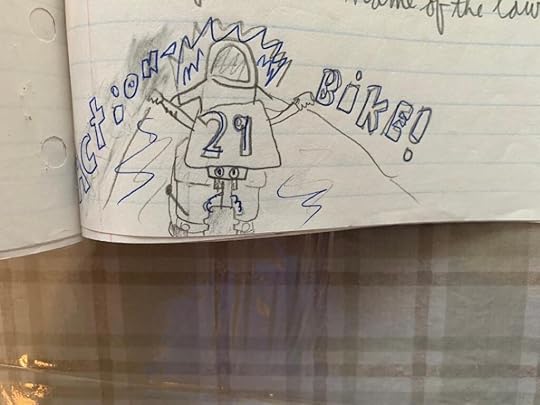
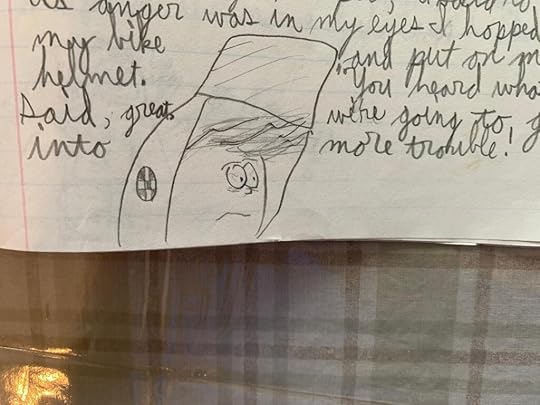 Here are a few more pics scattered throughout the original short story version of Danger Peak.
Here are a few more pics scattered throughout the original short story version of Danger Peak.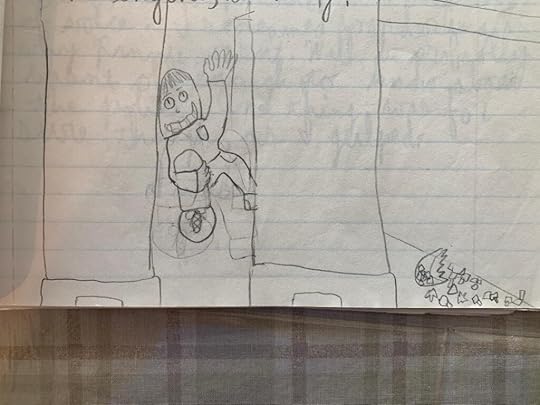 At this point, my beta readers are going to start recognizing moments from the story. Here is a shot of Robert hiding in his teacher’s closet, with a set of test tubes broken in the corner. (Those are supposed to be his teacher’s legs in the foreground.) Just why is Robert hiding? You’ll have to read the book to find out!
At this point, my beta readers are going to start recognizing moments from the story. Here is a shot of Robert hiding in his teacher’s closet, with a set of test tubes broken in the corner. (Those are supposed to be his teacher’s legs in the foreground.) Just why is Robert hiding? You’ll have to read the book to find out!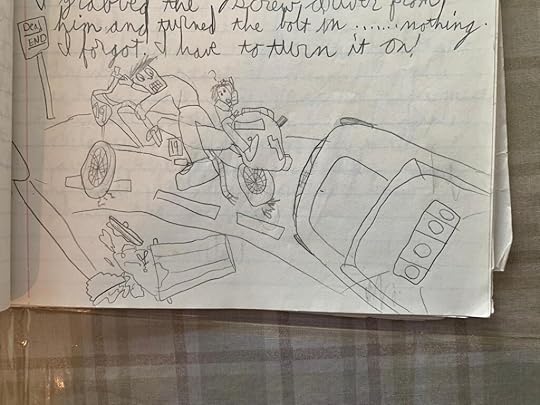 Here are two of the boys trying to escape the cops. In the novel version, the kids’ school guards are chasing them in this scene, and the cops end up chasing them later in the story (in other words, Escalation of Conflict 101). Why are they being chased by school guards and cops? I think you all know how I’m going to answer that question.
Here are two of the boys trying to escape the cops. In the novel version, the kids’ school guards are chasing them in this scene, and the cops end up chasing them later in the story (in other words, Escalation of Conflict 101). Why are they being chased by school guards and cops? I think you all know how I’m going to answer that question.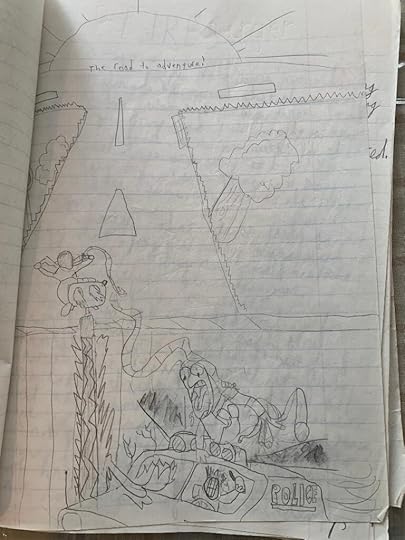 Here is an illustration of one of the action scenes, where Robert and Rinnie narrowly escape the cops by hopping over a wall. (Again, in the novel, they’re trying to outrun their school guards.) I remember being proud of this drawing at the time. (I especially loved the frustrated, mustachioed, cartoony cop in the corner.) Then again, I was 11.
Here is an illustration of one of the action scenes, where Robert and Rinnie narrowly escape the cops by hopping over a wall. (Again, in the novel, they’re trying to outrun their school guards.) I remember being proud of this drawing at the time. (I especially loved the frustrated, mustachioed, cartoony cop in the corner.) Then again, I was 11.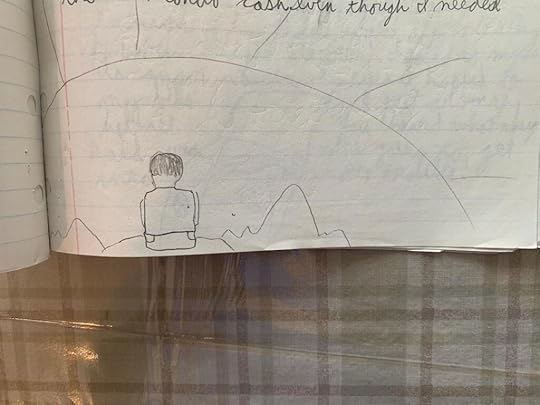 This is from the chapter titled “Determined.” (That chapter title is one of the few things that safely translated to the full-length novel.) In the original version, after getting caught by the cops, Robert spends the night camping outside with them and watches the sun rise, and this inspires him to climb Danger Peak once and for all. Of course, camping out with the cops doesn’t make a lick of sense (hey, I was 11!), so I changed it in the novel to the cops letting Robert off with a strong warning (there’s more to it than that, but I don’t want to give everything away) and escorting him and his friends home. Then, in the middle of the night, Robert wakes up to watch the sun rise from his bedroom window. This version is much more plausible. And that’s why pencils have erasers, kids!
This is from the chapter titled “Determined.” (That chapter title is one of the few things that safely translated to the full-length novel.) In the original version, after getting caught by the cops, Robert spends the night camping outside with them and watches the sun rise, and this inspires him to climb Danger Peak once and for all. Of course, camping out with the cops doesn’t make a lick of sense (hey, I was 11!), so I changed it in the novel to the cops letting Robert off with a strong warning (there’s more to it than that, but I don’t want to give everything away) and escorting him and his friends home. Then, in the middle of the night, Robert wakes up to watch the sun rise from his bedroom window. This version is much more plausible. And that’s why pencils have erasers, kids!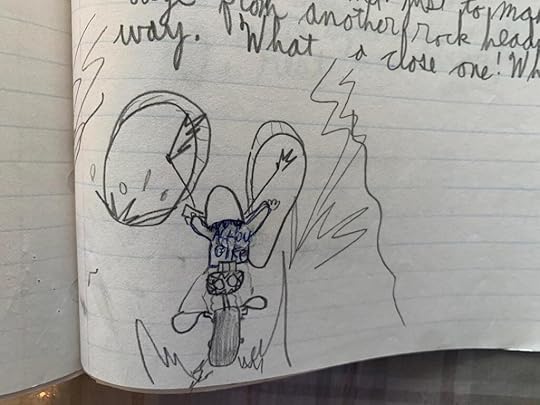 Here is a drawing of Robert climbing Danger Peak and blasting the boulders with a laser. At this point, I feel I’m giving too much of the story away, so I’ll stop here.
Here is a drawing of Robert climbing Danger Peak and blasting the boulders with a laser. At this point, I feel I’m giving too much of the story away, so I’ll stop here.Hopefully, you guys enjoyed this photo journey through Danger Peak’s history. If nothing else, after you’ve seen my crudely drawn illustrations, now you know why I became a writer and not an artist!
MTP
P.S.: Smash that Amazon button!
AmazonP.P.S.: If you happen to think Amazon is evil (and honestly, I can’t completely blame you), Danger Peak should be available at Barnes & Noble next week or so.
P.P.P.S.: My free book, Lists, Life, and Other Unimportant Details, is still available if you sign up for blog updates. As always, read the instructions on top of the Blog/FREE Book page for more info.
P.P.P.P.S.: Next week’s blog: Danger Peak’s Book Proposal
June 21, 2022
Danger Peak Is Finally Here!
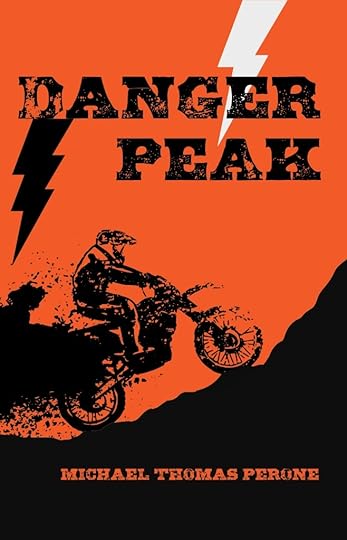
I made the mistake of minoring in Business when I went to college. For one thing, I’m not a numbers cruncher and still today don’t remember much of what I learned in my business classes (something about assets and liabilities). For another, it destroyed my Grade Point Average, which is why I would tell prospective employers after I graduated what my major GPA was, not my overall GPA.
Despite my struggles, my favorite business class was Basic Accounting, what people back in the day would call “Accounting 101,” and even though the stuff I was learning was pretty standard (it’s right there in the course title!), I worked harder than pretty much at any other course in my 4 years at college just to maintain a B average, something that would make the nerdy high schooler in me gasp in horror. I also really enjoyed my teacher, who was always quick with a well-timed quip. (Who knew accountants could be hilarious?) On the final day of exams, my teacher walked into class, slammed the large pile of test papers on his desk, paused for dramatic effect, and said, “Well…this is it.”
I laughed like a maniac. So much so, I actually had to apologize to my class, who had no idea why I was laughing. Even though it was probably unintentional, to me, what my teacher said was the perfect punchline to the long, difficult experience of trying to pass that class. Why am I bringing this up now? It’s because after years of working and sweating and slaving away to get my book out, it’s finally available now.
Well…this is it.
It’s here! It’s finally here! People can stop asking me when it’s coming out every time I post a blog! Will it be a bestseller? Will it bomb? Only time will tell! (But it’ll probably be something in-between.)
I’ve updated this site to include the link to purchase the book on Amazon at the bottom of every major page, not the individual blog pages (a Barnes & Noble link will follow in a week or so, and the eBook will be available in about a month), so be like the Hulk and smash that button! If you’d rather shop local, just go to your favorite Mom and Pop bookstore, and they’ll happily order a copy for you. And don’t forget to tell me what you think on my Contact page, unless you hate it. Just kidding…kinda.
As for the future of this blog, the purpose of it was to document the lead-up to the publication of Danger Peak, and now that it’s here, there seems to be less of a reason to blog. Truth be told, many entries had nothing at all to do with my book (remember that blog about “The Twilight Zone”?), so it’s possible I’ll continue writing.
There were many surprises in my blogging journey, one of which is that most of the people who chose to follow my blog are people I’ve never met. (C’mon, Facebook people, where y’all at?) Also, people found a way to get updates to my blog without opting in to receive their free copy of Lists, Life, and Other Unimportant Details, since they didn’t submit their email address in the opt-in box at the bottom of the Blog/FREE Book page. (Once again, if I don’t have your email, I can’t send you the PDF. Sorry, but that’s just basic logic.)
Probably the biggest surprise of this blog was having the executive producer of “Muppet Babies” “like” my blog on the show on Twitter, when I didn’t even tag him or the show. Apparently, Twitter is much more powerful than I realized.
I never meant for this blog to last forever. There are only so many ideas I haven’t already covered in my 270-paged blog book. I’ll still continue blogging on this site, but it will probably be less frequent—maybe once or twice a month instead of once a week. Of course, if there’s a major development with my book, such as a review from a major source or an upcoming promotion, the blog will be here to document it. And I may as well use this opportunity to put it out there in the universe: If you have a podcast or work for a website/newspaper/magazine, and you’d like to review my book and/or interview me, just get in touch with me using my Contact page.
Until then, happy reading!
MTP
P.S.: This is the first blog I’m not including a P.S.! Oops, too late. Well, now that I’m already writing one, here’s another Amazon link for the book:
AmazonJune 16, 2022
A Sneak Preview of Danger Peak
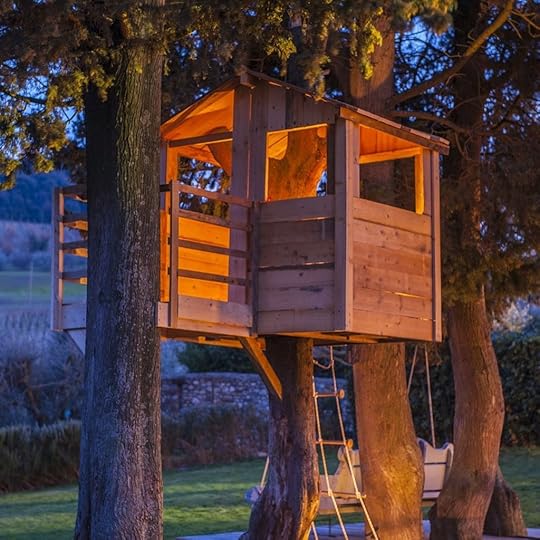 courtesy MAREMAGNUM/GETTY IMAGES
courtesy MAREMAGNUM/GETTY IMAGESIt’s been over three months since I announced my upcoming novel Danger Peak, and you guys have been patient enough, so I thought it was time to share a sneak peak (ha!) of the book: the Prologue and first chapter (so, essentially, the first two chapters). The Prologue was originally just the first chapter, but that was back when the book was titled Action Bike and the chapter was titled “Danger Peak.” I didn’t want a chapter titled “Danger Peak” in a book titled Danger Peak, but I couldn’t think of another title for the first chapter, so I changed it to the Prologue, which, in retrospect, seems appropriate since it feels more like a Prologue than a proper chapter. (It’s short and moody, and there’s no dialogue.) This was fortuitous because I ended up adding an Epilogue to complete the bookends that began with the Prologue and inadvertently came up with a better ending. (Even my beta readers agreed.)
As I mentioned in my blog last week, there’s a lot of world building I need to do in the first few chapters (not just confined to the ones I’m presenting here), so keep in mind nothing terribly thrilling happens because I’m still setting up the story and establishing the characters. (Also, the chapters do get longer farther into the book.) I thought about posting a few chapters that are more exciting, but they appear towards the middle of the book and would be completely out of context, and you would have no idea what’s going on. Still, I thought you’d be interested in getting a taste of my writing style (fiction wise) and what the book feels like, and I hope these first few chapters whet your appetite of the adventure that’s to come. Without further ado, here we go….
PrologueOctober 1989
Thirteen-year-old Robert Kin joyfully, almost mischievously, weaved his green customizable motorbike through the generic, manufactured labyrinth of his suburban town’s roads. Zipping along the treelined streets, he felt like a flying squirrel leaping from branch to branch. He liked to imagine the bony tree fingers were reaching out to him as he tried to outrace their grasp, and with the visor open on his safety helmet, he could feel the wind whipping at his face like a plunging skydiver.
Robert leaned gracefully into the turns until his body was almost parallel with the pavement. It was as if the bike were a part of him. As he scanned the rapidly approaching streets, the comforting vibration of the engine, quick burst of acceleration from the twist of the throttle, and jolt of noise made him feel like a god surveying his world. For Robert, the possibility of losing control, yet maintaining full control at all times, was the purest form of freedom. This level of exhilaration inspired him to create his town’s local dirt-bike club, the Wild Boars, with his best friend, Chris, and their short, often put-upon sidekick, Rinnie.
As he rode down the street, Robert noted the beauty of the leaves changing color and cursed the days growing shorter, which meant less time to ride his beloved bike. Fall was a particularly poignant season.
Robert purposefully rolled his vehicle through the fall foliage lining the cracked pavement. As he plowed through small piles of auburn-painted leaves just to hear the satisfying crunch, he dryly noted to himself, “Nature’s garbage.” This autumnal path of crispy detritus led him to his favorite landmark, the place he turned to time and again to get away from his small town and the even smaller-minded people within it.
Feeling somewhat like a soldier on a mission, he turned one last corner to enter the small patch of forest just outside the city limits. Slowing his bike to a stop, he switched the motor off and then dismounted. After removing his helmet, Robert sauntered up to the rusty gate emblazoned with the landmark’s name. The chill fall wind whipped his sandy brown hair, blocking his chestnut eyes. Annoyed, the seventh grader brushed his locks aside to read the dingy sign that seemed to have stood since time immemorial: “DANGER PEAK.”
There it was. It loomed overhead like a natural skyscraper, his town blanketed in its direct shadow. In order to see the entire mountain, Robert had to crane his head back at an unnatural angle. It smarted something awful, but the view was worth it. Danger Peak was almost twelve thousand feet high—just over two miles—and no one, not him or any of his friends, had been able to reach the top. Its peak was called insurmountable not just because of its height. Legends sprung from those brave enough to attempt the climb of an eerie mist that clung near the peak and obscured their view; gargantuan, fast-moving boulders that seemed to fling themselves at climbers from out of the ether; and, as if that weren’t enough, mysterious weather that welcomed travelers with spontaneous thunderstorms and gale-force winds. No matter what time of year it was or how beautiful the climate below, you could be certain all hell was breaking loose at the top of Danger Peak. It seemed supernatural. All of these obstacles mocked those intrepid explorers, daring them to once and for all conquer their neighborhood’s star landmark.
With a series of traps this diabolical, Robert and his friends reasoned there must be something spectacular the mountain was guarding at its peak: a pot of gold perhaps, like the fabled rainbow’s end, or maybe even a mystical secret of the universe.
The only glimmer of hope of scaling this impossible peak was the curious path winding its way toward the zenith. Somehow a dirt-bike trail had been carved out of the mountain’s side. Some say it was manmade, but Robert always wondered how that could be since no one had made it to the top—at least no one had made it back alive. In a way, the mountain’s trail was more a tease than a promise; it only made the journey more frustrating. Even with the aid of a motorbike, you still had to face the daunting gauntlet of mists, boulders, and never-ending storms. You still had to see through impenetrable fog and dodge deadly lightning strikes.
In fact, the closest someone had come to besting the mountain was Robert’s older brother, Danny, the year before. The high-school junior made it just over halfway before succumbing to the mount’s various traps. With the aid of a helicopter, the authorities found his body near the midpoint—his bike, in pieces, fifty feet away.
But that wouldn’t stop Robert. As leader of the Wild Boars, he knew he and his pals had to find a way to top Danger Peak. It was their one shot at becoming legends in the eyes of their school and hometown. More than that, it was his dream. Robert would find a way to be the first to scale the mountain . . . or die trying.
Chapter 1: The Wild Boars“You went back to Danger Peak . . . again?” Chris, Robert’s best friend since kindergarten, asked.
Chris, Robert, and their younger friend Rinnie were holding another meeting of their Wild Boars club in the large treehouse in Robert’s backyard. Chris and Rinnie’s dirt bikes were still parked at the wide, bumpy base of the ancient tree. Chris’s blue bike dwarfed Rinnie’s considerably; Rinnie’s gray bike resembled the first draft of Chris’s fully developed model. The younger boy’s bike was not only smaller but also less powerful than Chris’s or Robert’s, and he was often teased that it wasn’t much faster than a regular pedal-powered bicycle.
Perched in the yellow-and-orange-streaked sky of the late autumnal afternoon, the clubhouse was their stronghold against the outside adult world. As the wistful chorus of Don Henley’s “Boys of Summer” drifted from Robert’s miniature AM/FM radio mounted on the tanned ’70s wood paneling that made up the majority of their ramshackle treehouse, Robert musingly considered a title change to “Boys of Fall.”
“Man, you are obsessed!” Chris exclaimed, leaning back against the wall, almost inadvertently switching the radio off.
“Yeah,” the short, pudgy Rinnie chimed in as he casually flipped through an issue of Nintendo Power magazine, “and you’re also preoccupied!”
Chris rolled his eyes. “That means the same thing, dorkus,” he taunted their pint-sized sidekick. “How did you graduate grammar school with us again?”
“I copied my tests off your mom,” Rinnie wisecracked, tousling his ratty, rust-colored hair triumphantly. With that, Chris went in for a windup with his fist, but Robert, ever the peacemaker between the two, blocked him.
“That’s enough, you guys,” he said. “I didn’t call this meeting to start another fight.”
“Then why did you call this meeting?” Chris asked, gazing around the circular treehouse. A cartoon wall calendar featuring a black cat sticking its head out of the maws of a rotting jack-o’-lantern signified the month of October, and various magazine photos of specialized motorbikes adorned the walls. Then his eyes fell on Robert’s handmade poster that sported a crudely drawn purple boar screeching by on a motorbike while shouting their club’s motto in a hovering word balloon: “JUST HAVE FUN!”
“To just have fun?” Chris answered his own question, almost duty-bound.
“No,” Robert said immediately. Then, sensing his friends’ disappointment, he changed his tone and corrected himself. “Well, yes and no.”
“What’s that supposed to mean?” Rinnie asked. Rinnie was a sweet kid but a little slow. He was—as some impolite company would whisper behind his back—the so-called runt of the litter. With his short stature, hunched-over posture, and dirty hair, he resembled a rat. Occasionally, Chris would remind him of this in no uncertain terms, but this time was different.
“Believe it or not, I have to agree with Rinnie,” Chris admitted.
Robert pensively stared into the middle distance. Absently, he mused on how Chris’s straight jet-black hair and emerald eyes mirrored those of the calendar’s Halloween cat. He would’ve stood up to pace the room if it were big enough. As it was, even though his club was large by treehouse standards, the three of them had almost outgrown its one room since it had been built eight years before by his dad and brother, Danny. In fact, the treehouse was specifically built atop the tall, proud oak with Danny in mind, and subconsciously, Robert always felt like he was trespassing—especially after his brother’s death. It was like standing your army on hallowed ground, planting your flag on someone’s grave.
“Well?” Chris asked Robert impatiently, breaking his daydream.
“Oh, sorry,” Robert apologized.
“Apology accepted,” Rinnie said cheerfully.
“He was talking to me, butt wipe,” Chris spat.
“Oh, ‘butt wipe,’” Rinnie mocked. “That’s a new one. Very classy.”
“Remind me,” Chris then said, turning to Robert, “why do we let him in here?”
Robert was defiant. “I let him in here because it’s my treehouse,” he said, defending the oft-picked-on Rinnie.
“Thanks, man,” Rinnie said.
“No problem.” Robert smiled.
Chris screwed his eyes tightly, daring himself to correct his friend. “I thought this was Danny’s treehouse,” he said.
Robert inhaled deeply. “Right,” he said.
“Hey,” Rinnie interjected and pointed to his magazine, “do you guys know about the Konami cheat code?”
Chris suddenly lunged at Rinnie, rudely ripping his Nintendo Power away, and ordered, “Gimme that!”
“Stop,” Rinnie protested. “I just got it in the mail this morning!”
“Enough!” Robert shouted. At last, he gave his team the meeting’s agenda. “I think we should scale Danger Peak once and for all.”
“But hoooww?” Rinnie whined. Now even Robert was getting annoyed with him.
This time, it was Chris’s turn to defend Rinnie. “What I think he means is,” he softly began, “it’s been tried before. You know, Danny . . .” He purposefully let his words trail off. He felt he had already been pushing it with his former insensitive comment about the treehouse rightfully belonging to Robert’s brother. From the corner of his eye, the calendar cat seemed to be mocking him.
“I know,” Robert replied, “and that’s why we have to try it ourselves, for Danny’s sake.”
“Do you think he cares?” Rinnie asked in a surprising outburst. “I mean, he’s six feet in the—” Robert shot Rinnie a look that made him catch himself, and Rinnie’s cheeks immediately flushed crimson. Chris coiled his fist for another smackdown when they all heard Robert’s mother call merrily from outside their clubhouse.
“Robby, come in to eat, and say goodbye to your friends!”
Breaking the ice, Chris was the first to speak. “Your mom still calls you ‘Robby’?” he asked. A brief pause, and then the three friends erupted into nervous laughter. Not wanting to end on a fight, Robert put out his right hand, palm down, and announced their other catchphrase: “Friends to the end.”
“Friends to the end,” Chris and Rinnie repeated, placing their hands on top of his.
MTP
P.S.: Every time I post a blog, I gain at least one or two “followers,” which is great, but you should know if you simply “follow” my blog without entering your email address in the opt-in box at the bottom of the Blog/FREE Book page, I have no way of sending you your free PDF copy of Lists, Life, and Other Unimportant Details. I know I sound like a broken record, but I also don’t want people to think I’m peddling false advertising. For more details/information on how to sign up and get your free book, read the instructions at the top of the Blog/FREE Book page.
P.P.S.: Next week’s blog: The First (and Probably Last) Danger Peak Photo Essay
June 9, 2022
A Writing Memory
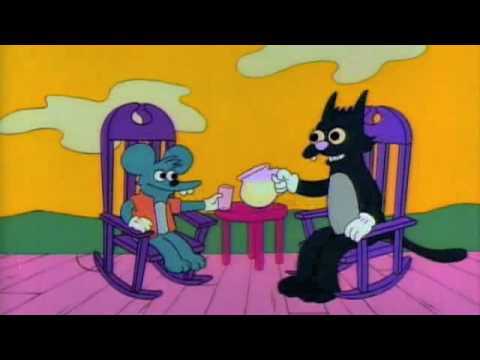 courtesy Twentieth Century Fox, Gracie Films, and I guess now Disney
courtesy Twentieth Century Fox, Gracie Films, and I guess now DisneyWhen I was in Fifth Grade, I was, as Ron Burgundy might say, “kind of a big deal” when it came to writing creative stories in class. My teacher enjoyed them, my fellow classmates seemed to like them, and most importantly, I loved writing them. Perhaps because of this, I felt pressure as our final writing project was nearing toward the end of the school year. This wasn’t just any writing project. This was the Oscars of Fifth Grade creative writing exercises. In fact, the best story in both Fifth Grade classes was going to be entered into a local young writers’ competition on Long Island.
The big day arrived, and I was so nervous, I sharpened three pencils when I knew I wouldn’t need more than one. My teacher handed out our writing assignments, and I quickly opened mine as soon as I received it. The story idea went something like this: “One day you run into someone who looks exactly like you. What would you say? What would you do? Describe the situation in as much detail as possible.” (This is going on memory from something that happened over 30 years ago, so I’m sure it wasn’t worded exactly this way, but it was close.)
I thought it was a great idea for a story, and the first idea that popped into my head featured a main character competing in an upcoming big race that his town held every year. He lost all the previous years, but after bumping into someone who looks exactly like him, he hatches a plot to have his “twin” hide out in the middle of the race track behind a bush so that as soon as the race begins, he would appear to have an enormous head start on his competition and win the race. I was about to start writing, but then I realized my teacher might frown on the fact my characters won by cheating. I was then stuck for an idea.
This was the first time I can remember having writer’s block. I nervously checked the clock, and it seemed to be racing by. Most students were already hurriedly scribbling down what I was sure were genius ideas, and I felt completely left out. A few poor souls were milling around the class maps hanging from the chalkboard in front of the classroom, desperately searching for ideas. At first, I mocked them in my head, but in a few short minutes, I was joining them in my own desperation.
“This is stupid,” I thought as I elbowed for room and glanced around the world map. “What exactly am I looking for? It’s not like if I see a certain country—” Then my eyes landed on Greece, and I remembered we learned all about Greek mythology that year. (The Greek myths inspired my young mind, and I even made up a song about Greek mythology, though I only remember the chorus: “Greek myths retold/They just get old!”) I decided I would create my own epic Greek myth, one that would blow my teacher away and make her proud.
I hurried back to my desk and started formulating my story. I don’t remember the details (again, this is over 30 years ago), but this is essentially the abridged version from my middle-aged memory: There were two warring, rival factions in ancient Greece, each headed by different but very powerful gods. (I made up my own gods with their own individual powers.) Their dramatic battles raged for years, yet they always ended in a stalemate; one clan was never able to defeat the other. Finally, one of the gods strikes a deal with Zeus to give him a new power of assuming the form of his enemy so they look exactly the same. One night, the two meet, and the god in disguise gains the trust of the other, never realizing that the opposing army is sneaking into his territory. (I borrowed this from the Trojan horse story, which I was also taught that year. Hey teach, I’m demonstrating applied learning!) In the end, the god who was able to assume a new form at last vanquished his enemy and army, and there was a huge celebration. It was epic. It was exciting. It was, I admit, a little violent. But honestly, what Greek myth isn’t? I mean, Zeus disguised himself as a bull to rape Europa. My myth wasn’t anywhere near that bad.
I handed my paper in with a huge smile on my face. It was probably the best thing I wrote that year, and I knew my teacher would love it. If I wasn’t selected as an outstanding story to enter our local writers’ competition, I knew I would at least be a finalist.
Weeks passed before our test results returned, and the wait was agony. At last the day arrived, and before our teacher handed out our stories, she made a proud announcement. “I am happy to report,” she began, her face beaming, “that one story in particular was so good, it’s going to be entered into the Long Island Young Writers’ Competition!” I leaned back confidently in my chair with a faux bashful, “Who, me?” look. I was certain she was talking about my story, but as I looked at her with an overly confident grin, she seemed annoyed. She glanced at me quickly and then looked away as she finished her remarks. “The student I selected is Brenda!”
Now, before I continue this story, you can be sure that the name “Brenda” is a pseudonym, as I don’t want to offend anyone, lest she or one of her friends/family members is reading this, which, let’s be honest, is highly doubtful. (This will make more sense as you continue reading.)
My heart fell. “What?” I asked myself. “But Brenda hasn’t written anything interesting all year! How is this possible?” I stole a glance at Brenda, my mind a seething, jealous rage, and Brenda seemed more surprised than I was.
Our stories were returned, and our teacher asked Brenda to read hers to the class, her face still beaming. “Okay,” I thought, trying to calm myself down. “Maybe her story really is good. Heck, maybe it even blows mine away.” I tried to have an open mind as we listened to Brenda anxiously, but proudly, read the fruits of her labor. Over 30 years later, I obviously don’t have her story memorized, but this is basically the shortened version from my memory:
One day, I was walking down the street, and I ran into someone who looked exactly like me! I couldn’t believe it! We even had the same color hair and eyes! “Wow!” we both said at the same time. “This is amazing!” I invited her over to my house, and we played board games and had lunch. Then we went outside to play. My mother felt like she had twin daughters. We realized we even had the same interests! We also traded outfits in my bedroom. We had a really great time together, and I didn’t want it to end. At the end of the day, I was very sorry to see her leave, but I knew we’d see each other again someday. The End.
“That was it?” I thought to myself. “That was the story that beat mine and every other story in class??” Even the original idea I abandoned had more plot than that! Years later, I would watch an episode of “The Simpsons” where Marge becomes so upset by the violence on the show-within-a-show “Itchy & Scratchy” that she gets the writers to tone down the antics until there’s literally just a scene of Itchy and Scratchy calmly rocking back and forth in rocking chairs on a porch and offering each other cool glasses of lemonade. That was it. That was the entire story. That was Brenda’s story. And my teacher ate it up (like Marge, I guess).
Summoning as much courage as my 11-year-old self could, I approached my teacher at the end of the day and asked what she thought of my story. “Too violent,” she immediately sniffed. And that was it. That was the end of my writing days in Fifth Grade.
I suppose my classmate’s story was the least controversial because absolutely nothing happened in it—at least, nothing of interest (unless you find people playing board games interesting). The point is that when you’re writing a story, there needs to be conflict. In other words, something has to happen. It can’t just be people sitting around talking to each other, unless you’re establishing characters and/or furthering the plot. This is a common problem with the first few chapters in a book because writers are so busy building the rules of their worlds, setting the characters on their stages, and “laying the pipe” of exposition, and I’m not immune to this problem either. The first few chapters of Danger Peak are probably the hardest to get through because there’s so much I have to explain to the reader. It’s 1989. There’s this mysterious, magical mountain that killed the main character’s older brother the year before, and he wants revenge. These are his two best friends, and they’re in a motorbike-racing club. This is their eccentric technology teacher. Yadda yadda yadda. This is one of the reasons why George Lucas said, “Screw it!” and had an exposition info dump in an opening text crawl in every “Star Wars” movie.
Years after elementary school, I saw Brenda in our high school library. She was being tutored by an Honors student. What subjects did she need help in? English and writing. I smirked at the irony as I passed her to head to my next class. I never saw her again.
MTP
P.S.: Don’t forget to sign up for blog updates to get my free book, Lists, Life, and Other Unimportant Details. If you don’t enter your email address in the opt-in box at the bottom of the Blog/FREE Book page, I have no way of sending you the book! (Even though you enter your email address to “follow” this blog, I don’t see it unless you enter it in the opt-in box.) For more details, read the instructions on top of the Blog/FREE Book page.
P.P.S.: Next week’s blog: A Sneak Preview of Danger Peak (Finally)! (Trust me; it took a lot of restraint to not title this blog “A Sneak Peek at Danger Peak.”)
June 2, 2022
The Difficulty of Living in the Moment
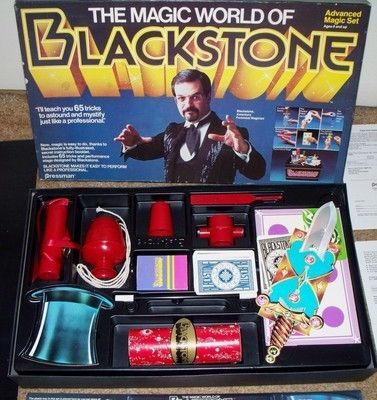 courtesy Pressman
courtesy PressmanLiving in the moment has always been difficult for me. I’m either obsessed with the past (once more from the top, I wrote a book that takes place in 1989) or worrying about the future. If I had to break it down into random percentages, which is a trait an ex-girlfriend found both annoying and fascinating, I’m about 80/20, with 80% being obsessed with the past and 20% worried about the future. My father noticed this before I did and would often compare me unfavorably to one of my friends who had a much better time living in the moment. My friend was always concerned about what was going on right now. Not yesterday. Not tomorrow. Today.
Perhaps the best example of this was during a rainy playdate in the late ‘80s. Forced inside because of the bad weather, which wasn’t a problem for me but I could tell annoyed my more athletic friend, we spent the afternoon in his small bedroom playing with various plastic playthings. When we got bored of that, he suggested whipping out his magic kit and putting on a show.
“I don’t want to do that,” I told him, for no good reason.
“Why not?” he asked.
“Because I just don’t,” I stubbornly answered, still unsure myself as to why. “I’m going home.”
I expected him to get upset and argue with me, but instead, he calmly shrugged his shoulders and said, “Okay.” His nonchalant reaction threw me, so I quickly hurried down the stairs to put on my shoes in a side room by the front door. (His family always insisted on visitors taking off their shoes, which I thought was an odd practice at the time when I now religiously do the same.) As I was tying up my sneakers, I heard his mother on the phone in the adjacent kitchen. Then my friend came down the stairs.
“Who are you talking to?” he asked her.
“Your uncle,” she answered.
“Oh, I wanted to tell him something. Give me the phone when you’re done.”
“Where’s Michael?” she asked.
“He went home,” he replied. She had no follow-up questions, as if it was a nonevent, which, in retrospect, maybe it was, but I was an overly sensitive kid (and still am a pretty sensitive man), and her nonchalance that mirrored her son’s practically disgusted me. Didn’t either of them care?
It then hit me: They didn’t even realize I hadn’t left yet. I had a few choices. I could announce my presence, apologize to my friend, and go back upstairs to play with his magic show, or I could attempt to quietly sneak out the front door when they weren’t looking like an oversized ninja. In the end, my stubbornness defeated my cowardice, and I snuck out the door. On the way out though, I accidentally shut the door a little too hard, almost slamming it. I was sure they heard me now and wondered if they thought it odd that I was eavesdropping on their conversation and didn’t even correct my friend when he mistakenly thought I already left.
On the walk home (I lived only around the corner), I remember how upset I was at my friend not being upset. Not to sound like we were going steady, but I wanted him to fight for me and our friendship. I wanted him to yell and say, “C’mon, man! Let’s do something!” when I turned his magic show down. Instead, he completely and unapologetically accepted it and was done with me. What’s more, he had already moved on to the next thing: a phone call with his uncle. That was the hot, new thing to do. He was living in the moment; I was already ancient history.
Memory is funny in how we don’t remember what we were wearing or what we exactly said or even what we did, but we always remember how we felt. I remember feeling expendable, though I didn’t know the word at the time. I did know the definition of the word “worthless,” though, and that’s how I felt: worthless. My friend merely wanted my friendship; being only a few years after my brother passed, I needed his.
If I could change one thing about myself, it would be to stop obsessing over the past and dreading the future, to live in the moment and truly embrace the day. I’m reminded of the refrain from “RENT,” my favorite musical of the ‘90s: “No day but today,” which in my middle age is a sentiment that now sounds corny and trite but is no less true. To put it another way: “Carpe diem,” or, just in case you haven’t heard this phrase a thousand times before, “Seize the day.” (As I used to pretentiously say in college, “Be the day, and the day will be for you.”) This is not just to parrot a famous line from “Dead Poets Society” but to actually feel it in your bones. This was the philosophy of the show “How I Met Your Mother,” which preached about a so-called “future nostalgia.” Your “good ol’ days” are now, so embrace them while you still can.
Last month on my birthday, I went to a fancy restaurant by the water with my family. My young daughters were getting impatient waiting for their meals, so I took them for a little walk outside around the waterfront. As we were gazing at the water, a large, beautiful swan swam up to us and peered up expectantly. “Hold on,” I said and went back inside the restaurant. I returned with an uneaten dinner roll from our table. After breaking it into bits, I handed the pieces to my two children, and they excitedly threw them one by one into the water. The swan happily gobbled up the pieces, splashing about almost in a dance. I thought to myself, “This is nice.” It wasn’t spectacular, but it was what I needed that day. I was living in the moment. One swan dance at a time.
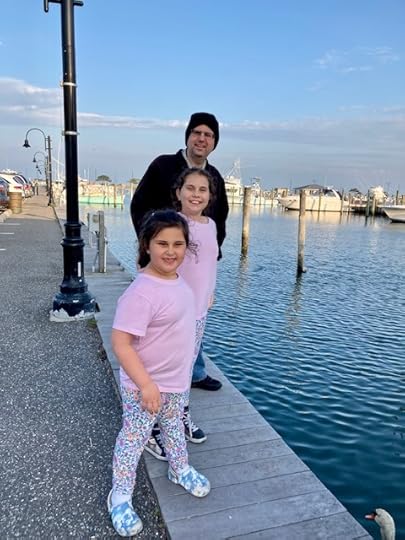
MTP
P.S.: Sign up for blog updates, and get a free book! Enter your email address in the opt-in box at the bottom of the Blog/FREE Book page, and click “Sign Up.” Once you do that, you’ll be automatically sent an email to confirm your email address. After you confirm it, you’ll be sent a free PDF of Lists, Life, and Other Unimportant Details, an over 270-paged collection of my best blogs and published articles over the past 25 years. Also, here’s another gentle reminder that if you simply “followed” my blog without entering your email address in my opt-in box described above, you won’t receive the free book. Without your address, I have no way of sending it to you.
P.P.S.: To all my email subscribers, I’ve noticed that the blogs you receive in your emails are missing the formatting (italics, bold, etc.), so for the best experience of reading my blogs, I would just click on the title of the blog in the email, which will bring you to this site with all the proper formatting.
P.P.P.S.: Next week’s blog: A Writing Memory
May 25, 2022
The “Twilight Zone” of Nostalgia
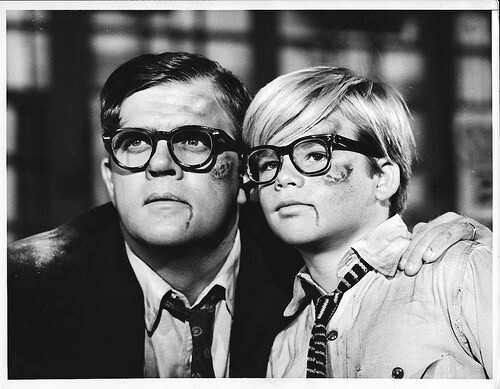 courtesy CBS Productions
courtesy CBS ProductionsI’m a person trapped by nostalgia (says the guy who wrote a book set in the ‘80s). When do these feelings start? Well, based on my own personal research (i.e., watching my kids), younger than you might think. My oldest daughter was a fussy eater when she was a baby (and still sort of is), so to get her to eat dinner, I would take out this toy that resembled a small house. It had secret compartments and open flanges she liked to take apart and play with as I spoon-fed her the Gerber’s jar of the day. Years later, when I was rummaging through old toys to donate or throw out, her eyes lit upon that same plastic house, and she immediately exclaimed, “Ohh yeaaaah!!” as if to say, “I remember that!” That was probably her first taste of the inexplicable frisson of nostalgia. (Yes, I just used the phrase “inexplicable frisson.” Deal with it.)
I experienced something similar a few years ago. In the late ‘80s/early ‘90s, there used to be a McDonald’s commercial that aired every Halloween featuring their famed chicken nuggets. They were puppetted to walk and talk, and I used to sneer, cynical even in my young age, “Who’d want to eat something that walks and talks?” (I guess I didn’t count cows mooing or chickens clucking as “talking.”) These mini-Muppets “acted” in these elaborate, miniature sets that resembled Frankenstein’s castle and other ghostly, haunted places, being that it was around Halloween. They aired the hell out of these commercials during my Saturday morning cartoons, prime real estate for fast food-addicted kids of the late ‘80s like me. At first, I thought they were cute, but after the zillionth time I saw them, I got so sick of them, I swore at the screen that I wished I’d never see them again.
Then, as if my old-school Zenith T.V. was a magic genie, I got my wish. They suddenly stopped airing, even the next Halloween — and the one after that. Cut to a few years ago when I was bored on YouTube and wondered if the commercials were on the website, captured on the Internet for eternity. To my amazement, they were, so I put one on and watched. What was my reaction? Was I still annoyed at the antics of these puppetted Mcnuggets? Did they make me laugh? Did they make me hungry? No.
I cried.
I cried not because the quality was so terrible, but because I realized how much I missed these commercials, cheap and cheesy as they were. Most importantly, so much had happened in my life between the time I swore at the T.V. I never wanted to see them again and a few years ago when I finally did. I was a boy. Now I’m a man. I had grown up. Nostalgia, baby.
I once took a photography class in college, and after I showed a fellow student one of my photographs and explained I was trying to balance the light and shadow in the shot, he pretentiously sniffed and said, “Light and shadow are overused in photography.” If I was less polite, I would’ve answered, “But photography is nothing but capturing light and shadow.” I feel the same way about writing and nostalgia. If someone complains that I rely too much on memory and feelings of nostalgia in my writing, I think, “But writing is nothing but trying to reconcile the past and capture the experience of living through time.” In my mind, what light and shadow are to photography, memory and time are to writing. In a way, writers are professional rememberers, which is why it pays to have a great memory.
I was thinking of all this when I recently watched an old episode of the classic, black-and-white series “The Twilight Zone,” titled “The Incredible World of Horace Ford.” (My wife is a huge “Twilight Zone” fan and has several seasons on DVD, and I occasionally watch an episode when there’s nothing on T.V.) The story is about a 30-something toy designer named (oddly enough) Horace Ford who is absolutely obsessed with his childhood, much to the consternation of his live-in mother, wife, and, especially, boss. You would think being in touch with your childhood is a great asset when you’re working in the world of toys (think of the movie “Big”), and you’d be partly right, but you may also forget how stubborn and immature children can behave, like when one of Horace’s designs for a robot is rejected by his boss because it would be too costly to manufacture.
“The eyes lighting up, that’s the beauty part!” he loudly whines to his boss when it’s suggested to eliminate that feature. You can tell even in the beginning of the episode that Horace’s job is not long for this world.
After work, Horace decides to visit his old neighborhood, and he is amazed when it seems nothing has changed, from a frankfurter salesman wheeling his cart through the street to the young couple splitting up and saying “bread and butter” to the woman in the window angrily yelling for her son to come home. Then he actually sees his childhood friends playing together — and they haven’t aged a day since they were 10. (This is a “Twilight Zone” episode after all.)
Horace returns home to tell his mother and wife what occurred, but of course, they don’t believe him, so he goes back, just to prove it to himself, when the exact same sequence of events repeats itself: the frankfurter salesman still happily offers his goods, the young couple still says “bread and butter,” and the woman still calls for her son in the window. For me, this was instantly reminiscent of “Groundhog Day,” my favorite movie of all time, where the main character seems to be repeating the same day over and over again. Of course, this episode aired 30 years before the movie, so you can’t claim Rod Serling’s show plagiarized the idea.
I’m not going to give away the show’s ending (it’s a good one; you should check it out!), but needless to say, Horace learns a lesson about living in the moment and letting go of the past. Ultimately, his wife imparts the moral: “I think we’re all like that,” she says. “We remember what was good and black out what was bad, because we couldn’t live if we didn’t.” She’s basically defining nostalgia in that moment, something I identify with a little too closely (at least as a writer). Besides the show’s theme, however, there were three other elements of the episode that hit home for me, coincidences so strong that they were almost as spooky as revisiting your old neighborhood and finding your childhood friends haven’t grown up.
1. Pat Hingle stars as the man-child obsessed with his past in the episode. Pat Hingle also starred as Commissioner Gordon in 1989’s “Batman,” a movie I was obsessed with as a child. (I had Batman toys, posters, notebooks, board games, and even a flashlight that made the Bat Signal, which one night burned a stain in my nightstand when I accidentally left it on all night.) As the years passed and I got older, I saw “Batman” as emblematic of the end of my childhood. It was released in the summer of ’89, the final year of my “official childhood.” It was the last summer I wasn’t a teenager and only a few months before I entered junior high. So here was the actor who had starred (okay, costarred) in the movie that I came to reference as the end of my childhood playing a man refusing to let go of his own childhood.
2. I watched the episode on the same date that it originally aired. I watched this episode for the first time this year on April 18. When I checked the liner notes of the DVD, it said the episode originally aired on April 18, 1963, almost 60 years to the day. Cue the creepy “Twilight Zone” music.
3. Mike Starr performed the radio version. One of the episode’s special features is the audio version of the story that aired on the radio in the 1980s. Character actor Mike Starr took the place of Pat Hingle (I’m assuming he was too old to play the role, even in the ‘80s) to play the titular character. Starr starred in (see what I did there?) Tim Burton’s brilliant “Ed Wood,” “Goodfellas,” the comedy classics “Uncle Buck” and “Dumb and Dumber,” and a memorable episode of “The Office” (U.S. version), among many others. How is this a coincidence for me? He happens to be the father of one of my wife’s childhood friends. (She grew up in the Bronx.)
What does this all mean? Probably nothing. But as I finished watching “The Incredible World of Horace Ford,” and I gazed at the sad, obsessed eyes of Pat Hingle as he desperately tried to wrestle his childhood into the present, I hoped that I wouldn’t end up like him. You can’t live in the past. But hopefully, I at least wrote a good book about it.
MTP
P.S.: Do you like free stuff? Do you like to laugh? No? Well, then pick up a free copy of my book anyway. Lists, Life, and Other Unimportant Details is an over 270-paged collection of my best blogs and published articles over the past 25 years. Read the top of the Blog/FREE Book page for more details.
P.P.S.: Loyal readers may have noticed I published this week’s blog a day early. That’s because I’m going to be too busy tomorrow doing Dad stuff.
P.P.P.S.: Next week’s blog: The Difficulty of Living in the Moment
P.P.P.P.S.: These postscripts may be getting out of control.
May 19, 2022
How the Series Finale of the New “Muppet Babies” Almost Destroyed Me
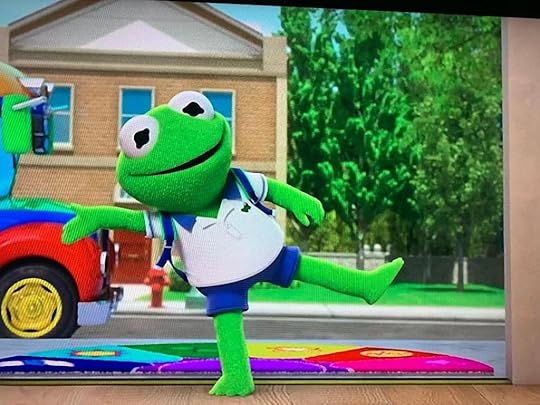 courtesy The Muppets Studio/Disney Junior
courtesy The Muppets Studio/Disney JuniorA few years ago, the Disney Channel announced they were rebooting “Muppet Babies,” and to add insult to injury, they were going to transform the charmingly flat, two-dimensional Muppets into CGI. Ugh, I initially thought when I heard the news, is nothing sacred? I was a bit of a super fan of the original “Muppet Babies,” which ran in the ‘80s on Saturday mornings, one of the few times cartoons were actually on T.V. at the time. (*shakes cane at the heavens* “You kids have it too good these days!”)
In fact, you could say I was there at Ground Zero of the “Muppet Babies” phenomenon. My Mom, bless her heart, took me to “The Muppets Take Manhattan” on opening weekend (something for which I’ll forever be grateful), and, as true Muppet-philes know, there is a short sequence in the film that served as the inspiration for the cartoon show, when Miss Piggy fantasizes that she wished she met Kermit when they were babies. Incidentally, that little scene, which was directed by Frank Oz in his solo directorial debut, is a magical delight, and I still marvel at how they got the puppets, er, Muppets to move without any strings or hands showing. I also love how the nursery looks almost identical to the cartoon version, with the giant circular window with ornate patterns the centerpiece of the room.
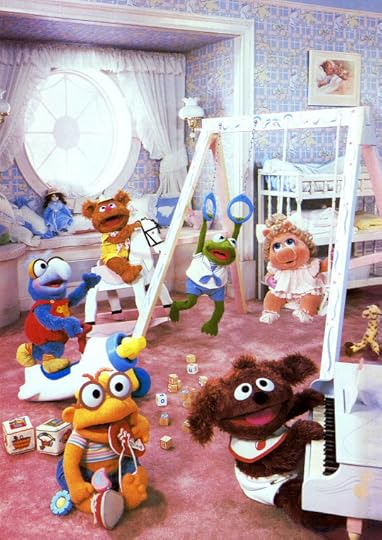
Not only did I religiously watch the show (both episodes back to back, after they canceled “The Garbage Pail Kids” cartoon, which I think ran for a total of 3 weeks, I’m not even exaggerating), but I had a subscription to Muppet Magazine, which had a regular department dedicated to the Muppet Babies. I also owned the Muppet Babies lunchbox, which was featured in “The Muppets” reboot movie with Jason Segel. (It was in the background of Walter’s bedroom.) That lunchbox made me the envy of my elementary school cafeteria, or at least I liked to think so. There were more than a few people who asked to examine the pictures on the box of the Muppet Babies lampooning miscellaneous movies. They would flip the box over to see parodies of “Raiders of the Lost Ark,” “Star Wars,” and others.
Being such a nerd, uh, fan of this show, and also being the father of two little girls, I felt obligated to at least watch the pilot of the reboot, and I was pleasantly surprised. The show seemed to capture the spirit of the original. The characters, voices, and humor all were familiar, except Nanny who seemed younger, though, true to her original incarnation, you still couldn’t see her face (I’m assuming so the audience could identify with whoever their nurturing caregiver was while growing up). The nursery even had the ornate window! What’s more, I enjoyed the original character Summer Penguin, which, I’m not too proud to admit, took me months to figure out the joke that she was a penguin named “Summer.” On top of that, I learned to appreciate the CGI metamorphosis of the characters, something I once viewed as sacrilege. It lent the characters a tactile quality; I swear I could reach into the T.V. and touch Fozzie’s fur. It was almost too real.
At first reluctant (they didn’t know the “Muppet Babies” from “He-Man”), my daughters eventually became fans of the show as well, until every episode was appointment viewing. But, as with many things, the kids got older, I got busier (hey, I’ve got a book to promote!), and watching the show became less and less important, even nonessential.
Then a few months ago, I read the description of an upcoming episode, “The Muppet Babies Show,” where the Muppet Babies put on their version of the original “Muppet Show” from the late ‘70s/early ‘80s. I thought this was a great idea for an episode and was surprised they hadn’t done it before. I gathered my girls together to watch this latest show, and we seemed to all agree that the quality was a par above the average episode. It’s about the last day before summer break when the Muppet Babies are going to go their separate ways and leave the nursery. So, to commemorate the time they spent together, they decide to put on one final show, which ends up being their version of the original “Muppet Show.” There are callbacks to classic skits like “Pigs in Space” and “Veterinarian’s Hospital.” There was even a hilarious bit where Bunsen Honeydew, as usual, messes up one of his inventions, and the Muppets’ voices are swapped several times over until you can’t tell who is who anymore.
Throughout it all, Kermit is worried about having to leave his friends once their show ends, and he keeps trying to sabotage the proceedings so the sketches never end and he can play with his friends forever. Of course, this sort of logic is sketchy at best (the Muppets have to end the show and leave the nursery sometime), but then again, the show is called “Muppet Babies,” not “Muppet Geniuses.”
I noticed how different this episode was compared to the others. It was slightly more melancholy and reflective. Also, it was longer. Most “Muppet Babies” episodes are two short stories that have nothing to do with each other, but this was one long story taking up the entire half hour. I realized that this must be the season finale of the show.
As the episode continued, Kermit panicked even more, since he doesn’t like change, something I can relate to a bit too well. In fact, he doesn’t calm down until the other characters comfort him by singing a heartwarming new song about accepting change while clips of past episodes played. That’s when it hit me: “Oh, this isn’t the season finale. It’s the series finale.” In a way, Kermit dreading the end of his show is a clever meta-commentary about the creators of “Muppet Babies” not wanting their show to end.
At the very end of the episode, Nanny gets all the babies ready to leave their beloved nursery once and for all. There is no dialogue, only soft, almost mournful music playing in the background (a carryover of the song they just sang). Then each main Muppet races to the front door of the nursey, turns around, and waves “Goodbye” to the “camera.” Summer waves her paintbrush. (Art was her talent.) Animal waves his stuffed bunny rabbit. Gonzo waves his crash helmet. Fozzie waves his rubber chicken. Piggy simply blows a kiss. Next, Kermit reaches the door, turns around, breaks the fourth wall, and directly addresses us, the viewers, at home: “See you later friends,” he says, “and thanks for all the laughs.” Then he leaves the nursery, forever. Finally, the “camera” pans up to that famous window, the sunlight streaming through it one last time.

I literally almost cried. This wasn’t fair. I already had to say goodbye to the Muppet Babies 30 years ago. Now I was being forced to do it all over again. And if I was upset, can you imagine how the writers, artists, directors, and other people who worked on the show felt? They were losing their jobs!
Call me overly nostalgic or maudlin, but the world is a worse place with less Muppet content. Sure, they’re corny, and the humor is more than a little hackneyed, but they’re innocent and don’t demand anything from us except not to take ourselves too seriously, to laugh at the world during the good times (and especially during the bad), and, most of all, to always use the power of your imagination. It’s right there in the theme song: “When the world looks kinda weird/and you wish that you weren’t there/Just close your eyes and make believe/and you can be anywhere.”
To grossly paraphrase Michael Douglas’ character from the terrific and terrifically underrated “Wonder Boys,” which is probably my favorite movie about writing (or trying to write), the world needs all the dewy innocence it can get, especially these days when it seems we’re minutes away from World War III.
Innocence, by its very definition, doesn’t last. Even though she’s only 9, I can sense this change in my oldest daughter already. We first visited the indoor waterpark/resort Great Wolf Lodge in the Poconos just before the pandemic hit (like literally 1 week beforehand; we just made it!). One of the attractions of the place is a game called MagiQuest, which is basically an electronic scavenger hunt where you wave a magic wand at various locations in the hotel to beat certain obstacles and get rewarded with points and “gold.” I remember how thrilled she was, excitedly waving her plastic wand through the hotel’s corridors. Her eyes would light up whenever she discovered something new.
When we returned to Great Wolf last month, I asked if she wanted to play the game again, and she shrugged her shoulders and said, “Nah.” What did she want to do? Borrow my wife’s cellphone to text her friends so she could boast about her vacation. I’m not trying to dump on my daughter (or the typical behavior of any tween), but my point is this: Parents, cherish the time you have with your young ones, because It Goes Fast. I know I was hugging my youngest daughter a little tighter than normal on my vacation, to the point where she was getting annoyed with me. And in case you’re wondering, no, she didn’t want to play MagiQuest either, but only because she usually follows whatever my oldest wants to do, since she looks up to her.
Hopefully, there’ll be another reboot of “Muppet Babies” one day, but I have a feeling this time, I won’t be watching it with my children, but with my grandchildren.
MTP
P.S.: Opt in for blog updates and get a free book! Yadda yadda yadda. You should know the drill by now. (If you don’t, follow the instructions at the top of the Blog/FREE Book page.)
P.P.S.: Next week’s blog: The “Twilight Zone” of Nostalgia



